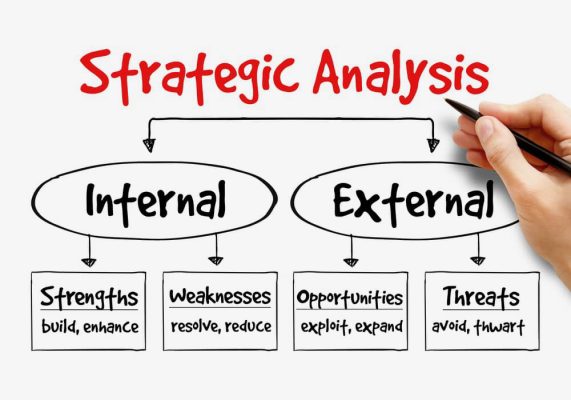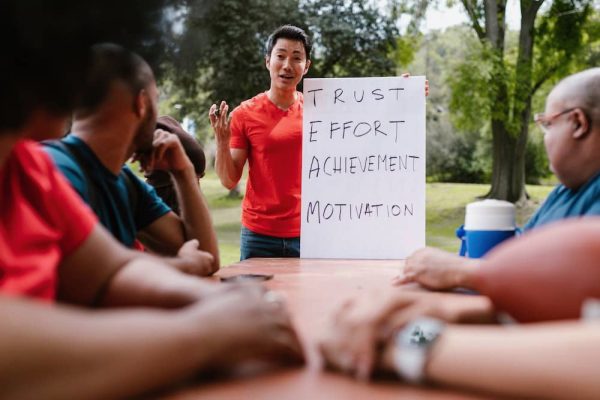https://nasacademy.com/blog/article/how-to-be-a-good-leader

Gandhi, Martin Luther King, Barack Obama, Nelson Mandela – all of these familiar, well-known names have something in common: they are considered highly influential leaders of their time. And while many people have achieved “success” in their positions as leaders, not all have necessarily been “good” in the process. In fact, when it comes to how to be a good leader, there really is no single, straight answer.

In a test done by Chief Learning Officer, 140 CEO’s were asked what they thought it meant to be a leader – and every answer was different. Some said leaders were those with certain interpersonal skills, while others said that a leader is someone who can accomplish certain operational tasks, or achieve specific outcomes.
Everybody you ask will have different ideas of what makes people leaders – especially today, where the role of a leader is becoming increasingly decentralized. So many people are taking charge, leading groups, and making changes when, historically, true “leaders” were considered those who gained a certain level of recognition, monetary, or social power. But now, people are making themselves leaders in their industries through making their own brands and businesses.
While there is no one set answer of what an actual leader looks like, or what leadership qualities one needs to have to make the cut – what’s important is that you define it yourself and have a cohesive understanding amongst your team of what leaders do, and what is expected of them.
The act of leading is essentially the act of guiding others to achieve a particular goal.
And some will speculate that there’s a difference between leaders or “managers” who simply do this job, and then there are good leaders who do this job and more.
As defined by the CCL, good leadership is defined as “a social process that enables individuals to work together to achieve results.” This points out how effective leadership isn’t necessarily about holding a position of power, but rather having qualities that foster relationships and allow leadership to naturally happen within teams.
And, in a report by McKinsey, effective leadership is generally defined as: “a set of behaviors that, in a given context, align an organization, foster execution and ensure organizational renewal.”
Clearly, there are many different ways to define “good” leadership. Because anytime the word “good” is involved, it’s always going to be subjective – and there are many different angles to be explored.
But, overall, good leaders all around are those who can accomplish goals, while also successfully and positively guiding a team to a desired outcome.
So while effective leadership is oriented towards accomplishing tangible goals and change, it’s equally defined by the process used to achieve them. A good leader is someone who people want to stick by – whose values aren’t just built around winning, and who doesn’t just manage and control, but who delegates and trusts.
Leadership is key for any project, organization, or brand looking for success and sustainability. But unfortunately, 77% of organizations say that there is a significant gap in leadership.
In the world of content creation, good leadership is an extremely important skill to have – and it’s a position that you will most likely have to take on at some point within your career. But, like many leaders, you may not have had any training or any past experience to land you in that top 23% where you want to be.
So, how exactly do you become a good leader without any leadership skills in your back pocket? Well, we’ve narrowed down 12 tips on how to be a good leader, and the skills that we believe are crucial to help you become the best guide you can be, and lead your team to success.
Before you try to lead others, you have to know who you are as a leader, and who you are as a person. Of course, some of us are thrust into leadership positions and are forced to learn the ropes of good leadership as we go – those who already have a strong sense of self, and know their goals, is the difference between those who succeed, and those who don’t..
Take some time to learn your leadership styles, know your tendencies, recognize your weak points, and don’t be afraid of them. Hiding and suppressing what is holding you back from being a good leader is a fatal flaw that will hold you back, because no leader has or ever will be perfect. And understanding that you are no exception to this rule is the first step to building yourself into an effective leader.
One way you can get to know yourself better is by doing a personal SWOT analysis. Draw a box and divide it into 4 different sections. Give each box a title: Strengths, Weaknesses, Opportunities and Threats. Now, fill it in – and be honest! This reflection exercise will give you an overview of where you are at personally, and doing these things regularly can help you continue to be self-aware and teach you to start valuing improvement, rather than dreading it.

As a leader, you need to make sure your team is on the same page. Know your goals, and make roles and responsibilities as clear as possible for every person on the team – and that includes yourself as the leader. Let your team know what they can expect from you in a leadership position, and what you expect from them.
This ensures that there isn’t any confusion on roles, and things can run smoothly from team to team. Furthermore, make sure people understand what it means to be a leader in this organization. People need to know what you will be doing, who to turn to when they need what, and what kind of behaviour is and isn’t tolerated.
Clear roles means clear boundaries – for you and your team. This will keep the morale high and the environment positive, and you can do this through regular check-ins to make sure people are on the same page, clear debriefs at the start of the week, and having a list of common values and goals that you all review together regularly.
Good leaders listen. As much as leaders should speak, guide, and take charge, it’s equally important for them to be receptive and observant. The last thing you want is a leader who gets tunnel vision, and has no interest in seeing what’s around them. When this happens, things get forgotten, opportunities are missed, and growth is impossible.
As a leader, you need to be an active listener. You need to be aware of your environment, opportunities, landscape, and you need to listen to your team – you must show them that they are being heard. Otherwise, you will be flying blind, and leading a team of unengaged and frustrated voices that are dying to be heard. Active listening allows you to assess your environment, respond properly, improve, and get feedback, and it allows you to build a relationship with your teammates – and building positive relationships and connections with your team is essential.
People need to be heard, and people need to be valued. By taking time to listen, you are openly recognizing that you don’t know everything, and that you are there to learn too. So, take some time to reflect on how much you are talking, versus how much you are learning. Practice active listening by allowing time for your team to speak in meetings, ask questions, and encourage discussions. And, when you do – listen carefully.

Good leaders are ones who are always looking to learn, not just through listening, but also through taking chances, and building an environment that fosters regular discussion and innovation – between both you and your team, and your teammates themselves.
The best ideas aren’t created alone; they come through teamwork, collaboration, and discussion. Create a space within your organization that makes people feel heard, and as if they can speak up and contribute ideas and experiment. This is what will move you forward as a team, and bring life into your organization. It’s how you can discover better strategies, reflect and pivot when needed.
Some ways you can do this is by encouraging learning and development sessions, creating discussion boards or groups where people can socialize, brainstorm, and get to know each other better. This discussion element is what brings connections between team members, and it’s what helps you do your job better as a leader. Have open workspaces in your organization, and always try to start discussions when making decisions, rather than simply ordering people around according to your agenda.
Learning how to be a good leader comes with learning how to make sacrifices, and sacrificing yourself. Whether it be time, reputation or ego, being a good leader means sometimes taking the heat when mistakes are made or things go wrong. As a leader, you are responsible for a lot more than the goal you are achieving, you are responsible for your teammates.
Your teammates are the people you must protect in order to keep the work going. And sometimes, that means acting as their shield, taking mistakes as your own and dealing with the things nobody wants to deal with. Of course, it’s a difficult job – no one said good leadership was going to be easy.
But doing this, knowingly and willingly, is what proves your strength and dedication to your goal and your team – and it’s what will earn you trust and respect from your colleagues. Better yet, fostering this relationship makes people want to do their best work for you in return. While this is true for any project you work on, it’s especially true for businesses.
“Great leaders make the hard choice, and self-sacrifice in order to enhance the lives of others around them. As a business owner, not only does your family rely on you – so too, do the families of those who work for you. Each employee has a family. Even if you’re a small business owner with four employees, you’re in essence potentially responsible for an additional ten or fifteen people.” – Joel Farar, Farar Law Group, Forbes.
If you want to know how to be a good leader, you need to trust. And trust as a leader is multifaceted – you must be able to establish yourself so your team trusts you, you have to trust yourself in your role, and you also have to learn how to trust others.
If any of these veins are weak, your leadership will be too. When you don’t trust yourself, you make mistakes out of a lack of confidence. When others don’t trust you, they won’t follow or support you. And when you don’t trust others, that leads to micromanaging – and your teammates will quit.

The level of trust in an organization is actually one of the main factors that helps decide Fortune’s “Top 100 Businesses to Work For.” A lack of it hurts engagement, productivity and drive – and people stop showing up. As noted by Thrive Global, the novel, 12: The Elements of Great Managing, concluded that a 10,000 employee company can lose $600,000 a year for work that has been missed because of disengagement alone.
So how do you trust yourself, others and get yourself to build integrity as a leader? It comes through openness, and through taking action. You have to earn trust, you can’t just ask for it. You have to show yourself and others that you deserve it. This means analyzing how closely you monitor your team, and work on unlearning micromanaging habits that you may have picked up. It means letting go of your self-doubt, it means being transparent, sticking to your values and your commitments, and letting go of control.
If you aren’t leading people properly, people will stop following – and then your job becomes obsolete. One of the most important leadership qualities you can have is remaining humble, and recognizing that leaders never accomplish anything alone. Without your team, you would be nothing. Work to be someone worth following, and be someone people want to follow – starting by acknowledging and respecting your team.
Learn how to empathize with your colleagues. Acknowledge the people around you, and understand their needs. After all, they are not machines, and they are not there simply to serve you. It can be such a simple thing to show someone you care and notice them, to acknowledge someone’s contribution – but it really goes a long way. Try rewarding your teammates, being grateful, and openly recognize their effort more often.
After all, 78% of people say being given gratitude makes them happier – and a happier team means higher productivity. 43% say that it boosts their confidence and 43% say they are also more motivated when they receive recognition. And if there isn’t enough appreciation happening, 79% claim they would quit.
Small things like words of encouragement, adding in bonuses, small rewards, or simply congratulating people and letting them know their value will show them that you appreciate them.
Too many leaders see their teammates as “followers” – but good leader’s don’t. They see them as colleagues. Teammates. The term “followers” creates a power structure, it creates a hierarchy suggesting the team must follow the leader – when really, a leader equally has to follow their team.
Things never go to plan, which is why adaptability and flexibility in a leader is essential. Your leadership approach and style in any given situation might need to change and fluctuate through the ups and downs of a project. Being able to do this seamlessly is crucial to help your team get through tough times, and make sure you all stay afloat.
Leaders need to wear many hats, and be receptive to what situations need what approach, and they need to be able to make these decisions in a split second. Now, it’s not to say that pivoting is going to be easy, or that it will be done right all of the time – but it’s the mindset you use to respond to these setbacks that matters. Having a malleable, open mind to help you navigate difficult situations is what will differentiate you from just being a leader, to being a great one.
Learn to be okay with letting things go, even if you feel strongly, if it’s for the betterment of the team. Learn to find different routes when you hit a roadblock, and accept mediocrity sometimes.
Freezing at the first sign of difficulty is not how you will achieve success. As a leader, you are a role model for the team – so set an example by not seeing set-backs as reasons to quit, and don’t let your fear outweigh your passion. Instead, build a growth mindset.

Having a growth mindset means you approach obstacles with curiosity, and see them as an opportunity to grow, rather than a sign telling you to stop. Pursue nonetheless, and show your teammates that perseverance is a choice, and that it’s always possible if you are open to new possibilities. When you can adopt this mindset, you will inspire your teammates to do the same. And building this in yourself and everyone you work with is going to leave a far greater impact than just achieving your single goal as a brand – it’s an amazing tool for anything in life.
Similar to fostering innovation, if you want to know how to be a good leader, you have to know how to see ahead of the curve. You need to be able to see beyond where you are right now and see the big picture. Remember: you are a guide to those around you. You need to know your next steps, before you get them to jump on board.
Do the work to foresee possible future hurdles you could encounter, or opportunities that might boost you up. You need to know how to plan properly for both the known and the unknown realities that will be coming your way. Try and plan and control as much as you can, and for what you can’t, plan contingencies. Plan to fail, and plan again.
What’s important is that you always think a few steps ahead. Being ahead means that people will have someone to look up to when they feel directionless – as a leader, you need to be that light for your team. Do your research, keep an ear out in your industry for any news, developments or anything that could impact you and your goals.
And while it’s important to look ahead of the curve for planning, it’s just as important to mentally look ahead as well. Good leader’s visualize where they want to be. They see the future they want to create, and they’re specific about it. The more you gear your mindset towards a particular end goal, the more likely you are going to act, and make decisions that will help bring it to life.
And if you can look beyond your single organization and see how you can turn your teams experience into one that gives each person something to bring with them, and you can consider the impact your values, choices and lessons will have on them and the world for years to come, then you’re thinking big. You’re thinking growth – and that’s what makes great leaders.
Another important one on the list of “must-have” leadership qualities is being personable, and having a positive attitude. People need someone to look up to – especially during difficult times. And as a leader, you should be that person. Being personable and positive will make it more likely for people to engage with you, trust you and come to you with any concerns or problems – and this way, you can support them better in doing their job.
Your uplifting personality is what’s going to keep up morale, and inspire that same morale between teammates. Not to mention, your mindset and personality is contagious. And through studies done and documented by author and CEO Jessica Pryce-Joans, it’s been shown that a positive mindset doubles employee productivity, doubles the length of their commitment to the company and makes them 6x more energized.
Practice being positive and personable by simply being present, listening, smiling, and make sure to allow some flexibility and fun in the workplace. Have casual conversations and connect with your teammates. You can hold regular, fun meetings, team-building trips, lunches, or team-bonding sessions that are unexpected – and step away from the boring “sit in a circle and tell everyone your favorite ice-cream flavor.”
Be creative, be positive and ask yourself: are you someone that you would want to follow and be around everyday? If not, you might have some work to do.
No leader should be immune to criticism. No leader should ignore the honest thoughts of those who they work with – because that starts to build a culture of control and dominance, rather than one of collaboration and community.
As a leader, you will always be changing. You will need to change according to the needs of your environment and your team, and therefore, you need to listen to their feedback. Value learning, and never think you are fine just as you are. Instead, find out how you can lead better because there will always be a way.
Some ways you can get feedback is to always ask if there are questions or feedback at the end of a presentation, meeting, or debrief. Give your teammates the space to share and to criticize you openly or confidentially. Hold regular leader evaluations every so often, and create a culture that values honest feedback, and deems it an essential part of the brand. The more you can show you are human, and willing to learn, the more people will open up and suggest ideas that will better your work as a whole.
You should also be investing in your skills if you really want to know how to be a good leader. Studies show that leadership training is actually significantly effective (even more so than previously thought) at improving leaders in terms of reactions, learnings, transfers, and results. Go to leadership seminars, take workshops, or do your own personal research and reading on how to better yourself. And if you don’t know where to start – don’t worry, we’ve got you covered:
Take your leadership skills to the next level and truly learn how to be a good leader with the Mentour Pilot Academy course, Learn Leadership From Mentour Pilot. This live class is hosted by Mentour Pilot – a pilot and content creator who has taken charge of his career as a content creator and refined his skills as a leader through piloting people safely and successfully all around the world.
Mentour Pilot will teach you the secrets on how to make split-second decisions, lead effectively, and how to use these skills to run your own brand and thrive as a creator. Sign up today and be a better leader tomorrow.
By Admin Nas Academy
By Team Nas Academy